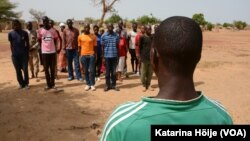When it comes to Mali, attention has focused on the conflict in the north, but over the past year tensions have been climbing in the central part of the country as well. New armed groups have emerged in the face of continued banditry and disputes over resources.
In the courtyard of the mayor’s office in Kerena, shaded by neem trees, young men sit idle.
No one is grazing their cattle anymore, out of fear, says Moussa Issa Bary, a herder from this village in Mali’s central Mopti region.
He says “we are afraid of everyone, mainly the armed bandits on motorbikes that roam the countryside, but also the security forces that arrest you if they find you in the bush because think you support the rebels.”
By rebels, he is referring to a broad and ever-evolving spectrum of armed groups that have been emerging around the Mopti region.
The most well-known is the Macina Liberation Front, a jihadist movement active since early last year, mainly in central Mali.
Bandits, militias
But criminality and conflict over land and resources are also destabilizing the area. Locals say there is little government presence outside the major urban areas. And Peul traders, herders and village chiefs told VOA that bandits and ethnic militias, some branding themselves as jihadists, have been recruiting young men.
Some analysts believe local bandits could just be adopting extremist rhetoric to scare authorities.
The mayor of the nearby village of Kerena, Ibrahima Hamadoune Bary, called the situation catastrophic.
He says people no longer dare to leave the town to go their fields. At one point, he says we had at least one deadly attack a week. In some villages, he says food is becoming a problem because the population don’t have access to markets.
The situation is even more complicated now than it was a year ago when the Bamako government signed a peace agreement with separatist rebels and other northern armed groups, says Boukary Sangare, a researcher studying the Mopti region since 2008.
Marginalized youth
He says “today the state is absent in several parts of the region where former members of armed groups have moved in. I call these people neo-jihadists because they used to cooperate with the Islamists.”
Some of these groups are attracting Peul youth who say they feel marginalized.
The peace agreement, signed in Algiers one year ago, focused on the three northern regions of Mali — Gao, Timbuktu and Kidal. The herders and farmers of the Mopti region were not represented.
Sangare says “because the state has been unable to address these issues some youth within the Peul community have felt it necessary to take up arms to defend themselves.”
Earlier this month, the National Alliance for the Safeguarding of the Peul Identity and the Restoration of Justice, known by its French acronym the ANSIPJ, announced itself as a military force. Its leader Omar al-Janah, a 27-year-old teacher, reportedly of Tuareg and Peul parents, claims to have 700 fighters at his disposal.
Claims of government abuses
In June, the U.N. Security Council voted to beef up the mandate and size of the U.N. peacekeeping force to Mali amid continued jihadist attacks in the north.
Sangare says central Mali should not be ignored.
“The center is the umbilical cord that binds the north and south together. If the Peul rise up, you risk losing the north and the center too,” Sangare says.
Residents of the Mopti region accuse the government of abuses and mass arrests, something that is feeding resentment.
This man says he was swept up by security forces with nine other men and detained for two months. He says when they arrested me I thought they would kill me. That's what they do with Peul men because they think we support the jihadists.
He says he was beaten and starved. His family paid to get him released.
He says we had to sell some of our best cows. My mother doesn't want me to go with the animals in the bush after what happened.
Peul activists and local leaders who spoke to VOA told similar stories of being arrested and their families having to pay for their release.
Kaman Kane, the governor of the Mopti region, justified the arrests, saying it was part of the strategy to suppress the violence in the region.














